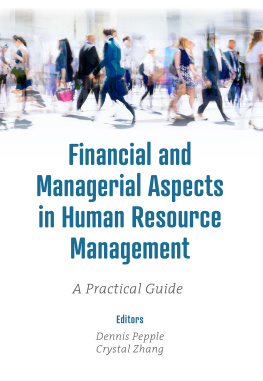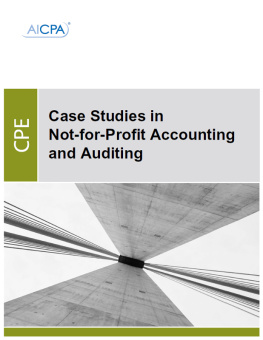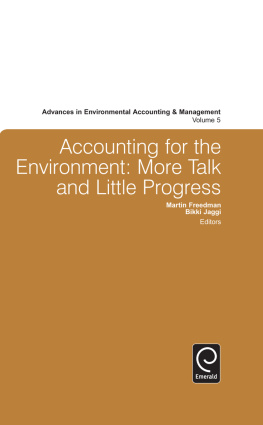HUMAN RESOURCE MANAGEMENT ISSUES IN ACCOUNTING AND AUDIT FIRMS
Human Resource Management Issues in Accounting and Audit Firms
A research perspective
JOHN A. BRIERLEY
Sheffield University Management School
University of Sheffield, UK
DAVID R. GWILLIAM
School of Management and Business
University of Wales, Aberystwyth, UK
First published 2001 by Ashgate Publishing
Reissued 2018 by Routledge
2 Park Square, Milton Park, Abingdon, Oxon OX14 4RN
711 Third Avenue, New York, NY 10017, USA
Routledge is an imprint of the Taylor & Francis Group, an informa business
Copyright John A. Brierley and David R. Gwilliam 2001
All rights reserved. No part of this book may be reprinted or reproduced or utilised in any form or by any electronic, mechanical, or other means, now known or hereafter invented, including photocopying and recording, or in any information storage or retrieval system, without permission in writing from the publishers.
Notice:
Product or corporate names may be trademarks or registered trademarks, and are used only for identification and explanation without intent to infringe.
Publishers Note
The publisher has gone to great lengths to ensure the quality of this reprint but points out that some imperfections in the original copies may be apparent.
Disclaimer
The publisher has made every effort to trace copyright holders and welcomes correspondence from those they have been unable to contact.
A Library of Congress record exists under LC control number: 2001089123
ISBN 13: 978-1-138-70252-3 (hbk)
ISBN 13: 978-1-315-20976-0 (ebk)
Contents
This study was supported by a grant from the Centre for Business Performance of the ICAEW and we are grateful to the Centre for its support and assistance in particular to Anthony Carey and Richard Macve. We are also grateful to Arthur Andersen, Deloitte and Touche, Ernst & Young, KPMG and PricewaterhouseCoopers for their willingness to allow us to interview senior human resource management personnel in their firms. In addition, we are grateful for the assistance provided by the libraries of the University of Wales, Aberystwyth, University of Sheffield, University of Manchester, UMIST and Manchester Business School.
We should also like to thank the following people who commented on all or part of earlier drafts: John Ashman, Carl Chadwick, Pegi Gwilliam, Judith Hardy, Steve James, Richard Macve, Geoff Pye, Helen Williams and two anonymous reviewers on behalf of the Centre for Performance Measurement. Especial thanks go to Anwen Gwilliam for her assistance in the preparation of the camera-ready copy.
Introduction
The rapid growth of accounting and audit firms over the last forty years, and in particular the transformation of certain firms into multi-national, multi-service providers employing many tens of thousands of staff, has given rise to recognition of the key importance of human resource management within these firms. There has also been an increasing awareness of the change in human resource management practice which has accompanied this transformation: and a questioning of whether existing models of staff management, organization and control are flexible and powerful enough to contribute to, and sustain, further development and growth.
In recent years there has developed, largely, but not entirely, in North America, a significant body of academic research into human resource management issues as they affect auditors and accounting and audit firms. The objective of this monograph is to present these research results in a manner which is both accessible and comprehensible to the interested reader.
The Audit Environment (Chapter 2)
The global commercial entities which the largest accounting and audit firms are today developed from modest beginnings in the nineteenth century. From the 1960s onward their growth has been spectacular and accompanying this growth was the adoption of a distinctive pyramidic staffing structure with concomitant high rates of staff turnover. In the last thirty years in the UK there has also been a transition from recruitment practices directed largely toward males not in possession of a university degree, to the situation today in which the great majority of new recruits are graduates and there is much more equality in the gender mix. Perhaps the most significant development in the last twenty years has been the tremendous expansion in the provision of services other than audit, for example taxation advice, corporate finance work, systems consultancy. In consequence, for none of the very large firms does audit work comprise as much as half of their overall fee income, and for some the proportion is much less than this. Recently, the desire to realize the economic value that has built up in activities beyond the field of accounting and audit has led to a number of large firms seeking to float or to sell off their consultancy operations. Notwithstanding this, it is likely that these firms will continue to be characterized by significant multi-disciplinarity in future years.
Features of the audit environment include: the diverse and contingent nature of audit assignments; the intense periodic time pressure under which auditors work; the constant requirement for accountability and review; the importance of the people factor both within audit teams and in working with the client; the aspect of negotiation in the audit outcome. In recent years the nature of audit itself has been undergoing a transformation and its scope has expanded to include a range of assurance services beyond the traditional periodic audit of financial statements. This has led to a degree of convergence between the audit and the consulting role.
The Research Studies: Issues of Methodology and Generalisability (Chapter 3)
The majority of the studies reviewed in this monograph have been carried out in North America by academic researchers. In most of these studies the research design has entailed testing on a statistical basis for the existence of hypothesised relationships between variables of interest. The use of psychometric methods to provide measures of many of these variables, for example personality type, job satisfaction, raises questions as to the reliability and validity of these measures and of whether the myriad of factors that influence human aspirations, desires and well-being can be captured by measurement systems designed to ensure statistical tractability. Although the studies identify many statistically significant associations between relevant variables, the overall explanatory power of the models has typically been low. This suggests that they fail to incorporate many of the factors relevant to the human resource management issues that they are seeking to investigate.
The preponderance of US studies focusing on US auditors and US audit firms brings into consideration whether there are particular cultural, economic or institutional factors which might limit the transferability of the findings of these studies to the UK and other countries. There are substantial similarities between the commercial and economic environments within which the firms operate in the USA and the UK and there are also similarities in terms of the organization and structure of the firms themselves. However, there are some relevant differences. One of the most significant is that in the USA the formal teaching of accounting and associated subjects and the passing of professional examinations takes place ahead of joining an accounting and audit firm. In the UK approximately half of those recruited by accounting and audit firms will have no academic background in accounting or business and the possibilities for sitting professional examinations ahead of joining a firm have been very limited. In consequence the education process is interwoven with that of training and acculturation, and the professional examinations loom large in the early years of a career in an accounting and auditing firm.









